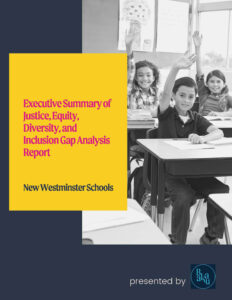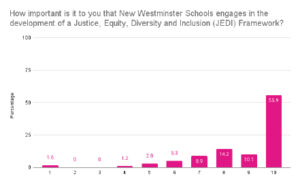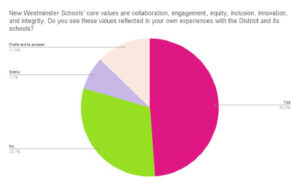Understanding and opportunities: the diversity and inclusion review
The drivers and goals
In the Spring of 2019, the Board of Education for New Westminster Schools took a formal stand against the wave of racism and discrimination that was dominating news cycles in Canada and the US, alongside other organizations who were calling for serious change. And, in doing so, they committed to engaging in the development of anti-racism and anti-discrimination policies and learning opportunities.
Over the course of the 2020-21 school year a small consulting firm, Bakau Consulting, worked with the District and the Board to do a review and analysis of where our school communities were at, using a combination of surveys and focus groups to better understand the beliefs, experiences and concerns of our students, staff and parents (including a limited number of general community members).
And while the driver for this work was around anti-racism, the work took on a larger lens of justice, equity, diversity and inclusion (JEDI), as we looked at various intersections of how discrimination can affect those in our community, based on very individual combinations of how we each identify as individuals.
 We’re excited to be sharing those results now … because we cannot improve if we don’t honestly know where we have opportunity to do so.
We’re excited to be sharing those results now … because we cannot improve if we don’t honestly know where we have opportunity to do so.
The final report that was provided to us is a gap analysis: quickly acknowledging the many successes, but mostly delving into the challenges and opportunities, as a way to focus on the work that needs to happen next as we continue on. That summary is included at the bottom of this page, but we’ve tried here to highlight some of the major findings and recommendations that the team at Bakau put together for us.
As we look at both the statistics reflected in the quantitative data, and the reflections shared in the qualitative research, we do so knowing that we would expect to see roughly similar trends in other districts. But there were also findings we were happily surprised to see, and some that are important flags for urgent work that needs to be done.
The methodology
The Bakau team gathered data through:
- External surveys that were completed by 422 students (the majority of which were high school students), and 797 parents and community members
- An internal survey that was competed by 248 staff members
- 7 focus groups (students, parents and community, staff)
- Review of 18 internal documents, including the District’s website and Facebook page.
For limitations around language, access and other related and acknowledged possible challenges, please read the Executive Summary linked at the bottom of the page.
We want to share our deep thanks to the almost 1500 people who took time to contribute their thoughts, concerns and hopes with us through this process!
While we are so appreciative of all those who took time to participate in this important work, we also want to be mindful of the fact that as we later dig deeper into the data, that small sample sizes in some groups should be noted, and limitations need to be considered.
This report is, as Bakau positioned it, a “micro-representation of nuances” that “will feel nitpicky at times” as it relates to focusing on barriers faced by marginalized folks.
Key survey findings
The questions on the survey have given us a broad range of feedback – on everything from the perceived importance of this work to ratings on how to report incidents when they arise. Here are some highlights of what the data has shown us.
Importance of developing a JEDI Framework
Based on a scale of 1 to 10, all groups were asked this question:
- How important is it to you that New Westminster Schools engages in the development of a Justice, Equity, Diversity and Inclusion (JEDI) Framework?
Here is the percentage of each group who said this work was important to them (as determined by giving it a rating between 6 and 10), here’s what we saw:
| Students | Staff | Parents | |
| Percentage of each group who stated that the development of a Justice, Equity, Diversity and Inclusion (JEDI) Framework was important to them. | 76.88% | 94.4% | 79.0% |

Calculated across the total number of participants, that means approximately 80% of the total people agreed that this work is important to them … with our District’s staff reporting the highest level of agreement with it’s importance (94.4%).
How are we doing on supporting diversity and inclusion?
Based on a scale of 1 to 10, all groups were asked this question:
- How would you rate New Westminster Schools when it comes to supporting diversity and inclusion?
Here is the percentage of each group who reported feeling like the District was doing a good job of supporting diversity and inclusion (as determined by giving it a rating between 6 and 10):
| Students | Staff | Parents | |
| Percentage of each group who reported feeling like New Westminster Schools was doing a good job of supporting diversity and inclusion. | 75.53% | 78.8% | 82.8% |
Calculated across the total number of participants, that means approximately 80% of people felt like the District was doing a good job of supporting diversity and inclusion, and approximately 20% of the participants rated the District as landing between a 1 and a 5, on the scale to 10.
Core values examined
Our students were asked this question:
- New Westminster Schools’ core values are collaboration, engagement, equity, inclusion, innovation and integrity. Do you see these values reflected in your own experiences with the District and its schools?

While more than half (56.5%) of the students felt like the District’s core values were reflected, to some degree, in their experiences with the school, we also see that close to a third (30.7%) of students did not see those values as reflections of their experiences.
Comfort in reporting
When delving into the processes surrounding incidents and reporting, one of the most notable statistics we found was in the student responses, when it came to their comfort in reporting.
Students were asked: Would you feel comfortable bringing up an incident to a school district employee. This question resulted in a nearly even split with 44% of students saying yes, they would feel comfortable bringing up an incident to a school district employee, and 56% saying no. In a follow up to this question, another shows us that only one-quarter of students report ever having brought up an incident to a school district employee.
This will be an important area for us to do work on, using additional data collected in this section to support a better understanding of students’ experiences with reporting an incident of violence or discrimination.
Representation
We know representation matters, particularly as we consider the role of intersectionality and identity. Here are a few key statistics we can pull from the demographic and data collection done as part of the Gap Analysis Summary …
When it comes to ethnicity, here are the top three identities represented by each of our three polled groups:
- Students: White (31.3%), East Asian (22.5%), South Asian (10.4%)
(Additional note: 8.8% reported as mixed race, 7.0% as Black/African/Caribbean or Afro-Caribbean, and 2.2% as Indigenous) - Staff: White (57.6.6%), South Asian (10.6%), East Asian (10.2%)
(Additional note: 4.9% reported as mixed race, 4.9% as Black/African/Caribbean or Afro-Caribbean, and 4.8% as Indigenous) - Parents and community: White (42.2%), East Asian (20.4%), Southeast Asian (8.8%)
(Additional note: 4.6% reported as mixed race, 5.0% as Black/African/Caribbean or Afro-Caribbean, 2.6% as Indigenous)
When it comes to other intersections, like sexual orientation, we also see demographic differences in identity between each of our three polled groups:
- Students: 71.8% identify as straight
- Staff: 82.8% identify as straight
- Parents and community: 89.2% identify as straight
When staff were asked to rate their level of agreement with the statement “I see myself represented in the leadership in New Westminster Schools,” over 60% of the staff agreed with that statement, with over 15% of respondents disagreeing with it.
Focus group
7 focus groups were held to add qualitative information to support the quantitative data. (Noting all focus groups had to be held virtually, out of respect for COVID restrictions in place through Spring of 2021, which may have affected participation.)
The groups included:
- Two student focus groups (counselling and support staff were available while sessions were held, as a measure of caution, to offer support to any students who may have felt triggered by conversations being had).
- Two staff focus groups.
- Two parent and community member focus groups.
- One District leadership focus group.
The conversations within these groups included:
- Proposals about immediate steps that the District can take forward in order to support justice, equity, diversity, and inclusion.
- Conversations concerning the difficulty in discussing issues such as anti-racism, social justice, or discrimination.
- Discussions about issues concerning representation at the District.
The qualitative feedback gathered from these sessions helped provide context to the data, fleshed out understanding of trends, and supported the development of recommendations presented within the Gap Analysis Summary.
Policy and document review
Over the course of the review, the Bakau team also looked at 16 of the most relevant Administrative Procedures, in addition to the District’s website and Facebook presence. Their review process flagged the following trends to consider as we move forward with the next stages of this process:
- Making sure documents are clear and consistent, including layout
- Updating language to make sure we’re reflective of evolving terms and terminology, including use of gender-inclusive terms
- Address accessibility where language or other barriers may exist
- Being clear and consistent around where and when community consultation should play a role
- Create a new policy to explicitly address Indigenous solidarity and decolonization
- Ensure intersectional approaches are used and named in development of policies and documents
- Look at where naming or specifically addressing anti-oppression plays a role in policies and their development
- Outline where there are accountability measures required when policy is breached.
Snapshot of the recommendations
The recommendations coming out of the Gap Analysis Summary delve into a number of areas … spanning from addressing current processes to considering new opportunities as we continue down this path. Here is a quick snapshot of some of the recommendations, as pulled from Bakau’s presentation to the Board of Education on November 23, 2021, framed under a few key headings.
Race, Ethnicity, Religion, and Language
- Hire more diverse teachers, staff, and leadership.
- Cultural competency and anti-oppression training for all District employees.
- The frequent inclusion of social justice topics within district-wide professional development days.
Gender Identity and Sexual Orientation
- Leaning on teachers who are members of the 2SLGBTQIA+ community and who are gender diverse to close the gaps in terms of access to information and highlight barriers that may be in place currently within the District.
- Ensure education for students and trauma-informed training for teachers.
Disability, Neurodivergency, and Accessibility
- Examine how the District interacts with students that behave “differently”.
- Normalizing conversations surrounding mental health that go deeper than simply acknowledging it.
The report
To get into the deeper details, you can read the full Gap Analysis Executive Summary, including links to additional justice, equity, diversity and inclusion resources: Gap Analysis Executive Summary – Prepared by Bakau Consulting for New Westminster Schools
The road ahead
As we look ahead, we’re excited about the opportunities this work is opening for us. There is clear support and need for this work, and we now have a clearer picture of where our most urgent needs are, as we look at how to engage our full school communities in all that will follow.
As we take more time to delve into the nuances and to develop the roadmap ahead, please know that we’ll be engaging many stakeholders as we continue this work.
The next steps:
- Our school communities will be taking some time to listen and absorb what the data is showing us.
- We’ll be working with Bakau to set up training workshops for staff … building up a foundational base across all our employee groups to better support and equip them to have further conversations.
- We’ll be creating a roadmap of what can be done now, and what work will lie ahead of us.
Expect to hear more. But, in the meantime, know that we’re thankful for the support you’ve shown (as staff, students, parents or members of our wider community). You’ve shared your reflections of where we’re doing well, and where there are opportunities and challenges that need addressing within our systems. And that’s invaluable feedback, because we know students, staff, families and our community will all benefit if we can break down the barriers some are facing, and if we can improve the way we deliver on equity, inclusion and diversity commitments and learning opportunities for all.
